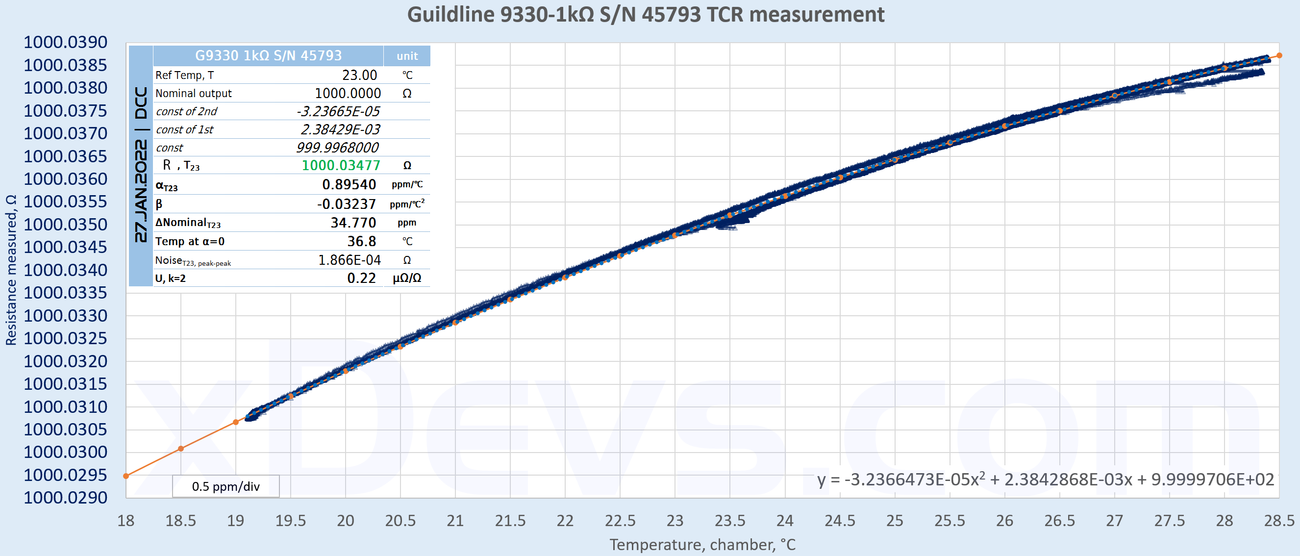Little report on testing of 1000 Ω Guildline 9330 resistor. This resistor was acquired from second-hand market. There was no known history other than calibration sticker label on resistor body from Cal-Matrix Metrology, Inc. which does not seem to have a web-site but located in Burlington, ON, Canada. Last known value from sticker is
1000.0250 Ω measured at somewhat strange +24.0 °C with unknown uncertainty.
Resistor arrived in decent shape without any damages, just slightly dirty. There was no oil residues that could suggest use in bath.
Other than already mentioned value and calibration date May 13, 2015 there is no much other useful information from the stickers.
So we will start measurements on this resistance standard and collect history starting from clean slate. Before that can happen binding posts and brass nuts were carefully cleaned with soft abrasive cloth and cleaned with 99% IPA.
Resistor then was connected to measurement setup with Measurements International 6010B DCC bridge to perform performance tests.
RAW Datalogs and results for 1000 Ω Guildline 9330, S/N 45793For the initial measurements at xDevs Lab in January 2022 this unknown resistor was placed in an air bath at nominal 23.0 °C ±0.1 °C. For better accuracy DUT temperature was measured with separate Omega capsule RTD and Fluke 1529 thermometer readout. This RTD was installed inside Guildline 9330 thermal well. The average temperature of the resistor was measured to be 22.992 °C and uncertainty of this measurement estimated ±0.18 °C. Standard resistor used in first test was
thermally stabilized Fluke 935-10kΩ S/N 001, placed in lab ambient environment.
Fluke 935 was running on battery during the measurement period.
Ratio between Fluke SL935-10k (316 µA) and MM Guildline 9330-1k (3.16 mA)Ratio between Fluke SL935-10k (316 µA) and MM Guildline 9330-1k (3.16 mA) in reverseRatio between xDevs.com's ESI SR104 (316 µA) and MM Guildline 9330-1k (3.16 mA)Ratio between T2 ESI SR104 (316 µA) and MM Guildline 9330-1k (3.16 mA)Ratio between Fluke 5720A/H1 9999.9769 Ω (316 µA) and MM Guildline 9330-1k (3.16 mA)Uncertainty and transfer analysis with Sandia PSL's open-source toolkit| Run, date | Rx | Ix | Rs | Is | Reversal time | Result | SDEV, ppm | ppm from average | Deviation from sticker |
| FSL935 FWD, JAN.9.2022 | 9999.9757 Ω ±0.3 ppm | 0.316 mA | G9330-1k | 3.16 mA | 20 s | 1000.03476 Ω | ±0.04 | +0.06 ppm | +9.76 ppm |
| SR104 forward, JAN.10.2022 | 10000.00128 Ω ±0.13 ppm | 0.316 mA | G9330-1k | 3.16 mA | 20 s | 1000.03477 Ω | ±0.03 | +0.07 ppm | +9.77 ppm |
| SR104 T2, JAN.12.2022 | 10000.0013 Ω ±0.13 ppm | 0.316 mA | G9330-1k | 3.16 mA | 20 s | 1000.03463 Ω | ±0.04 | -0.07 ppm | +9.63 ppm |
| Averaged | N/A | 0.316 mA | | | | 1000.03470 Ω ±0.18 ppm | | | +9.72 ppm |
| Final 27.JAN.2022 | N/A | 0.316 mA | | | | 1000.03477 Ω ±0.22 ppm | | | +9.77 ppm |
Based on these measurements we can estimate long-term drift of this resistance standard. To do so, one can take previous known calibration value from date May 13, 2015 which was 1000.0250 Ω with
unknown uncertainty. That was 2452 days from today, 27.JAN.2022. Today measured value is
1000.03477 Ω with uncertainty ±0.22 ppm (95%).
Deviation between two values =
( (1000.03477 Ω / 1000.0250 Ω) - 1 ) * 1e6 = 9.77 ppm of change.Making assumption of linear steady drift (which may not be true, but we don't have anything else to work with just two points history) we can calculate daily drift =
9.77 ppm / 2452 days equals
0.003985 ppm/day.
By multiplying this into 1 year =
0.003985 * 365 days = 1.454 ppm/year. This is still well within Guildline 9330 specification of ±3.5 ppm/year.
Temperature coefficient was also measured using two active Peltier air bath chambers.
RAW Datalog page with tempco measurement experiment
More details and internal design of Guildline 9330's also available
on my review/teardown article.